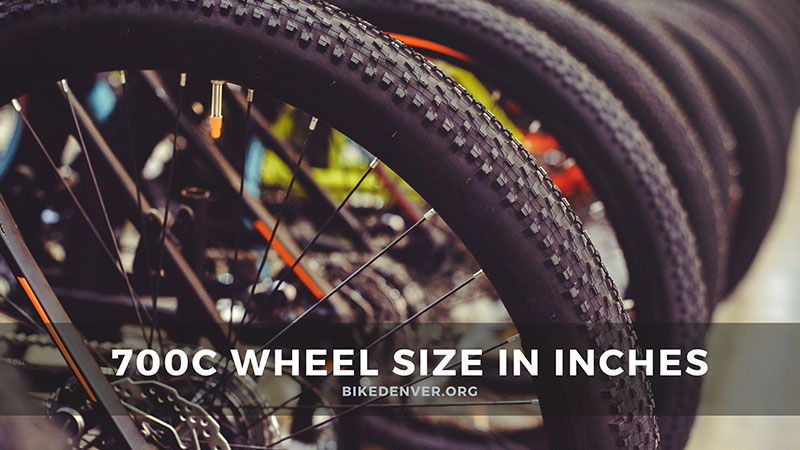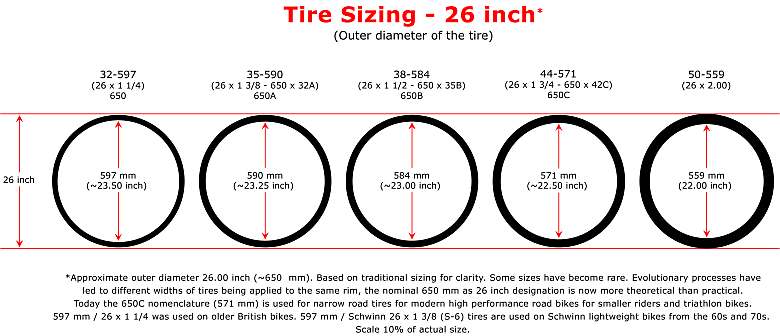The Significance of Wheel Sizes in Bicycles
Wheel size is a crucial aspect of bicycle design, significantly impacting the overall performance, comfort, and adaptability for various cycling disciplines. Selecting the appropriate wheel size is essential for ensuring a harmonious blend of speed, stability, maneuverability, and terrain suitability. Among the myriad of wheel sizes available, the 700c wheel size has emerged as a prominent choice for numerous bicycle types, solidifying its significance in the cycling world.
Decoding the Mystery: What Does 700c Mean in Bicycles?
The enigmatic “700c” wheel size designation is deeply rooted in the historical context of wheel sizing standards. The “700” portion of the label refers to the approximate outer diameter of the tire, measured in millimeters, when inflated to its recommended pressure. The “c” denotes one of the several tire width categories defined by the European Tire and Rim Technical Organization (ETRTO). In this case, “c” corresponds to a tire width range of 32 to 42 millimeters. Therefore, the term “700c” is essentially a shorthand notation for a specific wheel size, with a tire diameter of approximately 700 millimeters and a width between 32 and 42 millimeters.
700c Wheels: A Versatile Choice for Various Bicycle Types
The 700c wheel size has gained widespread popularity due to its versatility and adaptability across a diverse range of bicycle types. This wheel size is commonly found on road bikes, hybrid bikes, touring bikes, and cyclocross bikes, offering distinct advantages for each category:
- Road Bikes: 700c wheels provide road bikes with an excellent balance of speed, efficiency, and stability. The larger wheel diameter reduces rolling resistance, allowing for faster acceleration and higher top speeds. Additionally, the slender tire profile contributes to reduced aerodynamic drag, further enhancing overall performance.
- Hybrid Bikes: Hybrid bikes designed with 700c wheels offer a smooth and efficient ride, combining the best aspects of road and mountain bikes. The larger wheel size provides increased speed and efficiency on paved surfaces, while the versatile tire options accommodate various terrains, making them suitable for both urban and recreational cycling.
- Touring Bikes: For long-distance cycling adventures, 700c wheels are a popular choice among touring cyclists. The larger wheel size offers increased stability and a more comfortable ride over long distances, while the wide range of tire options caters to diverse road conditions. Moreover, 700c wheels can accommodate higher load capacities, making them ideal for carrying heavy gear during extended tours.
- Cyclocross Bikes: Cyclocross bikes equipped with 700c wheels provide the perfect blend of speed, agility, and durability for off-road racing. The larger wheel size allows for faster acceleration and higher top speeds on various terrains, while the sturdy construction withstands the rigors of cyclocross events, which often involve obstacles, jumps, and muddy conditions.
How to Determine Whether 700c Wheels Are Right for You
Deciding if 700c wheels are the best choice for your cycling needs involves careful consideration of various factors, including your height, weight, riding style, and terrain preferences. By evaluating these aspects, you can ensure a comfortable and efficient cycling experience tailored to your unique requirements.
- Height and Weight: Taller and heavier riders typically benefit from larger wheel sizes, such as 700c, as they offer increased stability, speed, and efficiency. Conversely, smaller or lighter riders may find smaller wheel sizes more maneuverable and better suited to their needs.
- Riding Style: For riders prioritizing speed and efficiency, 700c wheels are an excellent choice due to their reduced rolling resistance and aerodynamic advantages. However, if you prefer a more leisurely or off-road cycling experience, alternative wheel sizes may be more suitable.
- Terrain Preferences: While 700c wheels excel on paved surfaces and smooth terrains, they may not be the best option for rugged, off-road cycling. For mountain biking or cycling on uneven terrains, smaller wheel sizes, such as 26-inch or 27.5-inch, may provide better traction and maneuverability.
Ultimately, selecting the ideal wheel size for your bicycle depends on your individual needs and preferences. By carefully evaluating these factors, you can make an informed decision and enjoy a more enjoyable and efficient cycling experience.
Comparing 700c Wheels to Alternative Wheel Sizes
When exploring the world of bicycle wheel sizes, it’s essential to compare 700c wheels to alternative options, such as 26-inch, 27.5-inch, and 29-inch wheels. By examining the pros and cons of each size in terms of performance, versatility, and suitability for different types of cycling, you can make an informed decision about which wheel size best suits your needs.
- 26-inch Wheels: Traditionally used on mountain bikes, 26-inch wheels offer excellent maneuverability and are well-suited for tight, technical trails. However, they may not provide the same level of speed and efficiency as larger wheel sizes, such as 700c.
- 27.5-inch Wheels: Straddling the line between 26-inch and 29-inch wheels, 27.5-inch wheels offer a balance of maneuverability and speed. They are a versatile option for various terrains, providing a happy medium for riders who want a balance between agility and efficiency.
- 29-inch Wheels: Often found on cross-country and trail bikes, 29-inch wheels provide increased rollover ability and momentum, making them ideal for long, steady rides over varied terrain. However, they may not be as maneuverable as smaller wheel sizes, such as 700c or 27.5-inch.
While 700c wheels offer distinct advantages for road bikes, hybrid bikes, touring bikes, and cyclocross bikes, alternative wheel sizes cater to specific cycling styles and preferences. By understanding the unique characteristics of each wheel size, you can make an informed decision about which option is best for your individual needs and cycling goals.
Upgrading or Changing Wheels: Factors to Consider When Choosing 700c Wheels
When upgrading or changing wheels on your bicycle, there are several factors to consider to ensure optimal performance and compatibility with your specific bike. By understanding these factors, you can make an informed decision and select the ideal 700c wheels for your needs.
- Rim Material: Rims are typically made of aluminum or carbon fiber. Aluminum rims are more affordable and durable, while carbon fiber rims are lighter and offer better aerodynamics. Consider your budget, performance goals, and riding style when selecting a rim material.
- Spoke Count: The number of spokes in a wheel can affect its strength, weight, and aerodynamics. Generally, a higher spoke count provides increased strength and durability, while a lower spoke count reduces weight and aerodynamic drag. Evaluate your riding style, terrain preferences, and load requirements when determining the ideal spoke count for your 700c wheels.
- Tire Width: Tire width significantly impacts the overall performance and comfort of your bicycle. Wider tires offer better traction, shock absorption, and grip, making them suitable for off-road cycling or touring. Narrower tires reduce rolling resistance and aerodynamic drag, improving speed and efficiency on paved surfaces. Select a tire width that aligns with your riding style and terrain preferences.
- Wheel Weight: Lighter wheels generally offer better acceleration and maneuverability, while heavier wheels provide increased stability and durability. Consider your riding style, terrain preferences, and performance goals when selecting the appropriate wheel weight for your 700c wheels.
Popular brands and models known for their quality and performance in 700c wheels include Mavic, Shimano, Campagnolo, Zipp, and Reynolds. Always ensure compatibility with your bicycle and consult with a professional mechanic or bike shop if needed.
Maintaining and Caring for 700c Wheels: Tips and Tricks
Proper maintenance and care are crucial for ensuring optimal performance and longevity of your 700c wheels. By following these best practices, you can keep your wheels in excellent condition and enhance your overall cycling experience.
- Wheel Truing: Regularly inspect your wheels for trueness, as misaligned spokes can lead to reduced performance and increased wear. If you notice any wobbling or rubbing against the brake pads, consider having your wheels trued by a professional mechanic or using a wheel truing stand at home.
- Bearing Maintenance: Over time, wheel bearings can accumulate dirt, debris, and moisture, leading to reduced performance and premature wear. Regularly clean and lubricate your wheel bearings to ensure smooth operation and longevity. Consult your wheel’s user manual for specific maintenance instructions.
- Tire Pressure Management: Proper tire pressure is essential for maintaining optimal performance, traction, and comfort. Regularly check your tire pressure and inflate or deflate as needed. Refer to the recommended tire pressure range indicated on the tire’s sidewall for guidance.
- Regular Inspections: Routinely inspect your 700c wheels for signs of wear, damage, or loose components. Pay particular attention to the rim, spokes, and hubs, addressing any issues promptly to prevent further damage and ensure continued performance.
By incorporating these best practices into your regular bicycle maintenance routine, you can keep your 700c wheels in excellent condition and maximize their performance, safety, and longevity. Regular inspections and adjustments are crucial for ensuring optimal cycling performance and enjoyment.
Maximizing the Potential of 700c Wheels: Techniques and Skills for Enhanced Cycling Performance
Mastering the art of cycling with 700c wheels involves refining various techniques and skills to improve overall performance and enjoyment. By focusing on proper pedaling techniques, cornering, climbing, and descending strategies, riders can maximize the potential of their 700c wheels and enhance their cycling experience.
- Pedaling Techniques: Develop a smooth and efficient pedaling technique by engaging the entire pedal stroke, from the top to the bottom. Focus on applying power evenly throughout the pedal rotation, and consider using clipless pedals and cycling shoes for improved efficiency and control.
- Cornering Strategies: Proper cornering techniques are crucial for maintaining speed and control when navigating turns. Look ahead to spot your line, keep your weight centered, and apply even pressure to both brakes. Gradually lean your bike into the turn, and avoid abrupt movements or sudden changes in direction.
- Climbing Strategies: When tackling hills or inclines, focus on maintaining a consistent cadence and efficient pedaling technique. Stand up and shift your weight back when necessary, and avoid excessive mashing or grinding gears. Utilize your gears wisely, and plan your ascent strategy in advance to conserve energy and maintain momentum.
- Descending Strategies: Descending requires a balance of speed, control, and safety. Keep your weight centered and maintain a firm grip on your handlebars. Use both brakes evenly, and avoid locking up your wheels or skidding. Plan your line in advance, and anticipate any obstacles or turns that may require additional braking or maneuvering.
By continually refining these techniques and skills, riders can maximize the potential of their 700c wheels and improve overall cycling performance and enjoyment. Practice and patience are key to mastering these strategies, so be sure to invest time and effort into developing your cycling abilities.







)

